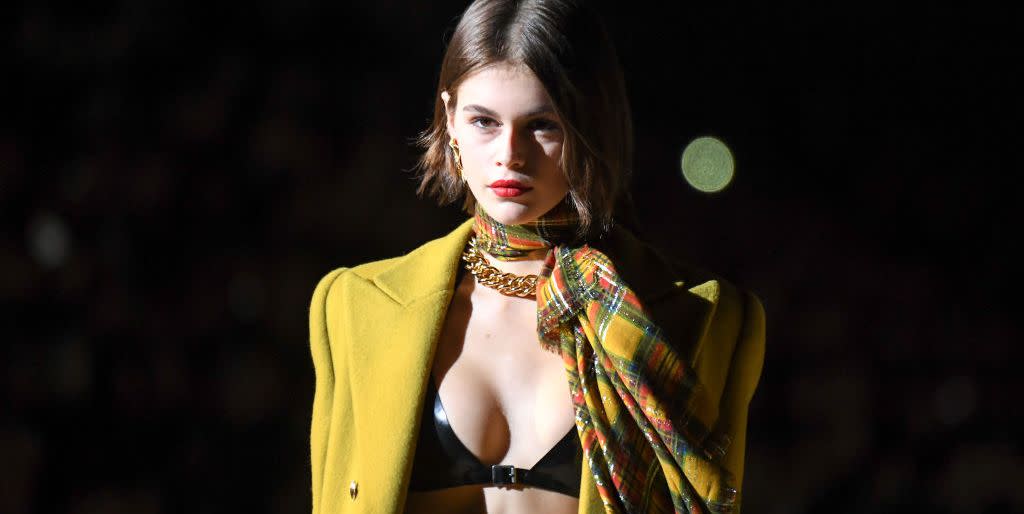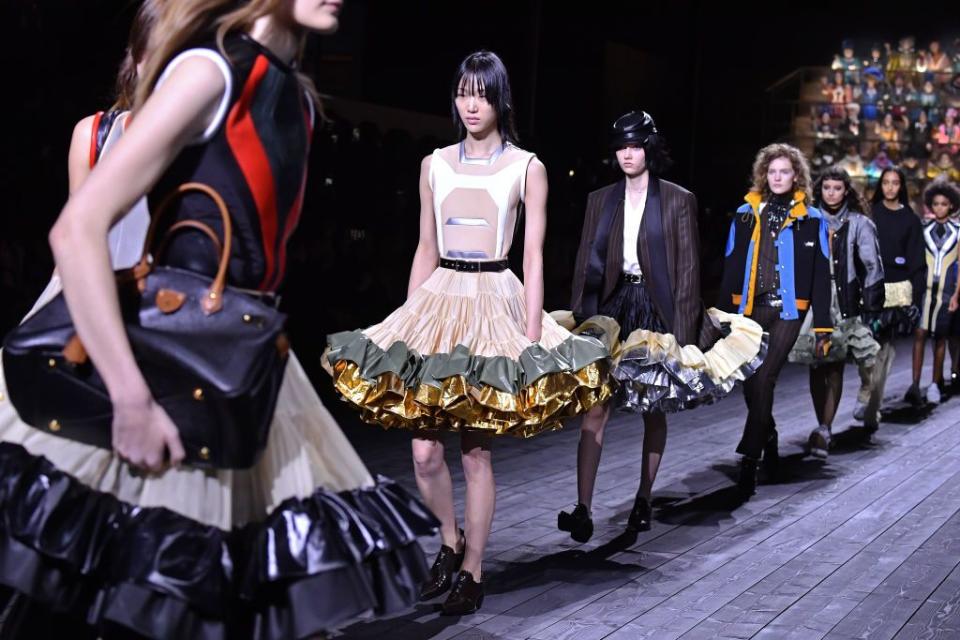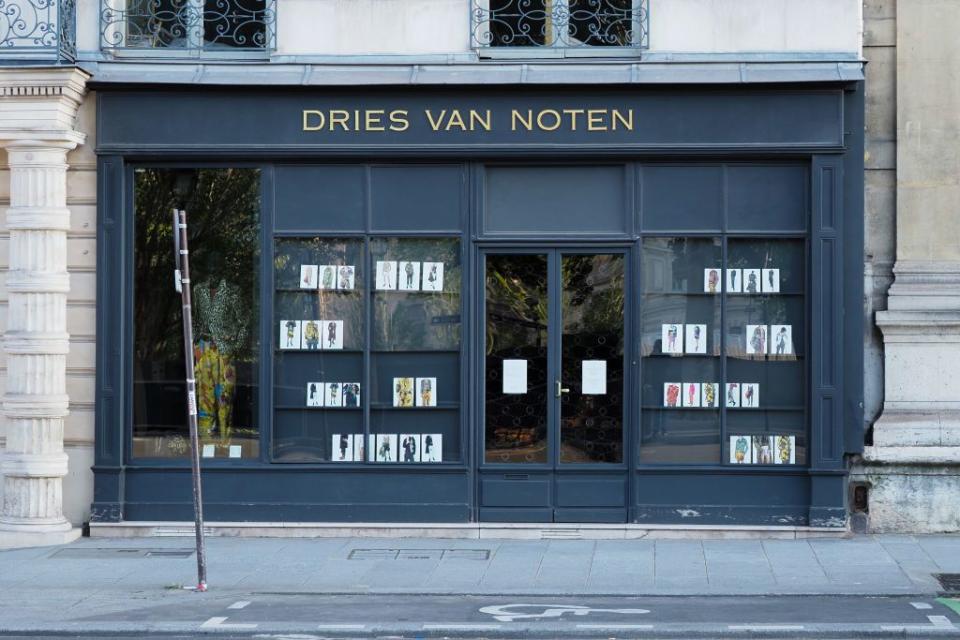Fashion's New Order – How Coronavirus Has Changed The Industry

‘We shouldn’t be here,’ was the refrain in February, when editors and buyers from major retailers around the globe gathered for Milan and Paris Fashion Weeks. At the time, Italy had the highest number of coronavirus cases in Europe: 152, a number that seems unthinkingly small now. Schools and government headquarters had just closed as a ‘precautionary measure’. While news of an outbreak in China cast an ominous cloud over proceedings in Milan, the spectacle of fashion week – a lavish showcase of the world’s most valuable brands, with supermodels, celebrities and press gathered under one roof – continued.
Covid-19 was yet to be officially declared a pandemic, after all. Yet ‘the show must go on’ quickly went from a defiant rallying cry to a question amid uncertainty about the scale of the virus’s impact. While Dolce & Gabbana proceeded with its 121-look show, Giorgio Armani uninvited guests on the same day, instead live streaming its AW20 show ‘to safeguard the wellbeing’ of those originally invited.
Then came Paris Fashion Week, and a rush of dropouts. US-based buyers and press rapidly cancelled hotels and rebooked flights – their eyes on Skyscanner in the front rows, rather than next season’s hit shoe styles (Mary-Jane platforms, in case you were wondering). Some brands reported 20-30% of guests reneged on their RSVPs. Air kissing – the quintessentially French greeting – was a faux pas, replaced with a polite, albeit anxious, nod.

‘People stopped travelling, and I started to understand that this was very serious,’ says Jeannie Cho, head of womenswear buying at Selfridges. ‘My first thought was: “how are we going to buy merchandise?”’ This might seem like someone else's problem, but it's key for us, as customers, because fashion week is about more than shows. It’s a crucial selling period, with Paris also home to showrooms where leading retailers place orders for the clothes we should be buying right now.
Those spliced skirts, chubby shearling coats and prints unique to AW20 will likely never see our wardrobes, either due to retailers not surviving nationwide lockdowns, or the clothes simply not making it into production. While the threat of a global pandemic remains, shows can’t go ahead as they once did, factories that produce the clothes can’t operate, designs teams can’t meet. What happens when a $2.5 trillion global industry grinds to a halt, as it did this spring? And, when the time comes that we can speak about the pandemic in the past tense, will the fashion industry ever be the same again?
Fashion weeks will certainly look different. That became immediately obvious when travel restrictions were put in place, with no one, however important they might be, exempt from travel bans and nationwide lockdowns. (One thing in fashion over which Anna Wintour remains powerless.) The pre-collections in May were immediately affected – those who follow the autumn/winter shows hosted in February and March, typically lavish travelling spectacles in which luxury brands fly guests to far-flung locations. Prada was set to host its Resort 2021 show in Japan, Gucci in New York, Chanel in Capri and Max Mara in Saint Petersburg. What happened to those is indicative of the one certainty about the future of fashion shows and, in fact, the fashion industry in general: there is ‘no one size fits all’ model. All change here.
A post shared by Alessandro Michele (@alessandro_michele) on May 24, 2020 at 7:09am PDT
‘We went way too far,’ Gucci creative director Alessandro Michele admitted after a period of silence, six days after Gucci’s planned Resort showcase. He was referring to fashion’s unrelenting schedule of up to eight collections per year, rather than just two (spring/summer and autumn/winter). ‘At the end of the day, we were out of breath,’ he declared in a 1,200-word facsimile of a typewritten note posted on Instagram, that was essentially saying one thing: Gucci, the world’s second-most-valuable luxury brand, on track to hit €10 billion in revenue in 2020, is saying ‘ciao’ to the traditional show schedule. Arrivederci, pre-collections.
Saint Laurent, also owned by luxury conglomerate Kering, announced plans to ‘take control of its pace and reshape its schedule’. ‘This has really tapped into some of the existential questions that the industry had been asking themselves for a long time,’ says Robin Givhan, Pulitzer Prize-winning fashion critic for The Washington Post. ‘They’re asking themselves questions about these other collections – pre-fall, resort, couture, menswear and other capsules – and the travelling shows that have an enormous environmental footprint. It seems like the opportunity the industry has been wishing for to start over, and put some best practices into place, knowing now what they didn’t know 10 years ago when they set off on this trajectory of showing collection after collection.’
Designers, to use a much-sullied term, want to take back control. For years, it seems retailers and major brands were swept up by the maelstrom of consumer demand. (You don’t continually smash revenue targets, as Gucci, Saint Laurent, Chanel and more have – the latter recently announcing 2019 sales of $12.3 billion, up 10% from 2018 – without consumer appetite.) Demand, stoked by customers’ desire for newness, boosted profits, and of course brands happily obliged, until, as Michele says, it all got too much. Which is why, three months into the pandemic, Belgian designer Dries Van Noten – renowned for his ornate elaborate style – rallied retailers and leading industry figures to sign an open letter calling for major changes; ones that benefit customers, too.

If you’ve ever tried to buy a bikini or summer dress at the height of summer, only to find they’ve already hit sales and are out of stock, you’ll know that the fashion industry’s seasons are out of sync with actual meteorological ones. Van Noten says this is about ‘making [collections] more environmentally and socially sustainable and ultimately align them more closely with customers’ needs’.
He, along with the likes of Tory Burch, Chloé, Erdem, Marine Serre, Grace Wales Bonner and more, ultimately want to reduce the number of runway shows and the sheer amount of clothing produced, as well as selling collections in real-time. That is, sending spring/ summer collections to stores in – gasp – spring/summer, between March and August, and autumn/ winter in – yes, you might have guessed – autumn/winter, between September and February.
UK and US fashion governing bodies, the British Fashion Council and the Council of Fashion Designers of America, are in favour of this, releasing a joint statement that says: ‘there is a clear disconnect from when things arrive in store to when the customer actually needs them’, and encouraging brands on both sides of the Atlantic to slow down. ‘We strongly recommend designers focus on no more than two main collections a year.’ Does this mean this fashion industry is pushing reset? No, actually.

Chanel still took customers and press to Capri for its Cruise 2021 pre-collection in June – digitally, with a virtual event it called ‘Une Balade en Méditerranée’ (a Trip to the Mediterranean). For the privately owned luxury brand, it is very much business as usual, just like the rest of us who continued working at home due to the pandemic, just shifting to Zoom – albeit more high-end, featuring bougie bouclé jackets and matelassé pedal pushers.
The French brand is staunchly committed to the old way of doing things, announcing it will stick to six shows: two ready-to-wear, two couture, plus cruise and Métiers d’Art (a show dedicated to showcasing the craft of its specialist ateliers). It’s not alone, with Dior among the first major fashion houses to announce it would go ahead with it’s couture show with a ‘special approach’ – a 15-minute film, released in July, directed by Italian filmmaker Matteo Garrone. It also showcased its cruise collection in Puglia –physically hosting it in the southern Italian region, with actual models, live-streamed for a digital audience. In fact, for most luxury brands, Covid-19 has simply prompted a shift in medium, rather than a reset, with many participating in digital fashion weeks.
Between declaring Covid-19 a pandemic and now, a number of digital-only showcases have taken place in three of the four fashion capitals: London, Milan and Paris (the CFDA has announced that New York Fashion Week will take place digitally in September). ‘What is fashion week without shows?’, you might wonder, as Alexander Fury, a critic for the Financial Times and fashion features director at independent magazine AnOther, asked. He answered that question with another question: ‘What is fashion week without clothes?’ Because what these digital showcases fundamentally are is content, offering designers visibility with digital projects – exhibitions featuring imaginative photography, films, panel discussions, playlists, and podcasts – in lieu of actual new collections.
‘People didn’t have time to produce new collections,’ Fury explains of London Fashion Week in June, typically a menswear showcase. So the British Fashion Council offered brands a way to share their work online, transforming London Fashion Week Men's into a digital event combining men's and women's collections – londonfashionweek.com became a platform for content produced by both. ‘It is a very important strategy to have content – more and more so – as a way for customers to understand what we and our brands do,’ says Sybille Darricarrère, buying director at Galeries Lafayette department store in Paris.

‘The brand doesn’t just exist through clothes,’ adds menswear designer Bianca Saunders, who participated in London’s first digital-only fashion week in June. ‘It exists through other mediums that are about more than just fashion – other ways to connect with a brand or designer, or build community. There are a lot more projects that I wanted to work on that I didn’t get to fully execute until everything stopped due to the pandemic. I didn’t actually show a new collection in June.’ Instead, Saunders unveiled a collaboration, featuring clothes first presented to buyers in September 2019, with photographer Joshua Woods and model and poet Jess Cole: a collectible limited-edition photo book that was a visually arresting, original exploration of the wider themes that inspire the clothes.
For many, the shift to digital showcases has highlighted the extent to which the attention during fashion week is on content, rather than clothes. It’s on the whimsical fashion films and Instagram filters allowing us to interact with extravagant couture frocks, such as those produced by Dior; or the 12-hour live-streamed marathon, featuring a narrative and behind-the-scenes action, like that by Gucci.
A post shared by Gucci Official (@gucci) on Jul 17, 2020 at 5:12am PDT
This has taken some pressure off smaller brands to keep up with luxury behemoths – those who produce between six and eight collections and invest a huge amount of money in physical shows. ‘I don’t think I have to follow the bigger brands any more,’ Saunders says. Womenswear designer Rejina Pyo, whose brand is stocked by renowned luxury retailers including Browns and Net-a-Porter, agrees: ‘This is a great opportunity for us to think about what we can do differently, as the same system has been in place forever. This has been a great time for reflection, and has given us the opportunity to implement some changes we have been talking about as a team for a long time.’
The shift to digital has been advantageous for many smaller independent brands, as it’s also allowed buyers at major retailers to commit time to showroom appointments they would have otherwise missed, typically wasting hours driving across Paris between shows during fashion week to attend buying appointments with major luxury labels. ‘We are buying a lot digitally, which is exciting, as I usually have so little time to go to all the showrooms, but it’s much easier for me to now drop into a 10-minute Zoom call and meet people globally,’ Darricarrère says.
She also points out that the buying windows have changed since the advent of ‘see now, buy now’. ‘We’re able to buy month-by-month, to have different buying periods, rather than the traditional two or four or six-month seasonal cycles. We started doing that a while ago, as it became more of a priority to quickly adapt to what the customer wants when they want it most.’ That flexibility means smaller brands don’t need to stick to the traditional fashion calendar to be seen or sold by major retailers.
A post shared by British Fashion Council (@britishfashioncouncil) on Sep 3, 2019 at 9:23am PDT
Smaller brands, like those supported by NEWGEN (pictured), don’t need to stick to the traditional fashion calendar to be seen or sold by major retailers.
Jeannie Lee, head of womenswear buying at Selfridges in London, echoes that sentiment. ‘It’s an initiative of ours to support small designers,’ she says. ‘We’ve seen a real shift over the past few years: “see now, buy now” got stronger and stronger, to the point where it was even more specific – to the month, to the week,’ so the business model adapted to that.
‘I have wondered if big brands will stick to a six-show system, and smaller brands will go for a two-show system,’ Fury says. ‘A lot of brands, if they do a show, they will likely do a show, because fashion shows work for them as a communication tool’, meaning that luxury brands’ livestreams of physical shows, such as Dior and Valentino’s recent spectacles –rather unappealingly referred to as ‘phygital’ – may just be a temporary fix until social distancing rules and travel restrictions are relaxed.
‘I think we’ve got to stop looking for a universal rule. There isn’t a rule that can be applicable to everyone, because the industry is so big and multifaceted,’ Fury adds. ‘What might come out of this is that the old system will erode away and the industry will become even more multifaceted and more flexible than it has been.’
The buying business will still be conducted behind closed doors, whether digitally or not, and fashion shows have become public-facing events rather than trade shows. So can our appetite for newness, as customers – new trends, new styles – be satisfied with specially considered projects unveiled during fashion week, rather than new clothes every two to six months? Can we satisfyingly engage with the fashion industry’s creativity through original – ephemeral – online content?
That would certainly be more in line with the sustainable messaging that’s been front-and-centre of late, calling for us to produce and consume much less. One thing is certain: absolutely nothing is certain. But this is an opportunity for the brands to rethink how they operate – whether they seize that opportunity or revert back to normal post Covid-19 is for them to decide.
Like this article? Sign up to our newsletter to get more articles like this delivered straight to your inbox.
In need of more inspiration, thoughtful journalism and at-home beauty tips? Subscribe to ELLE's print magazine now and pay just £6 for 6 issues. SUBSCRIBE HERE
You Might Also Like


